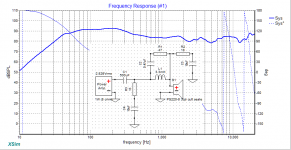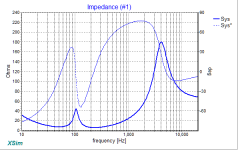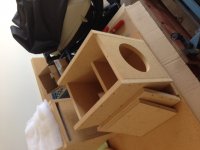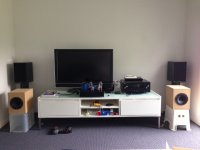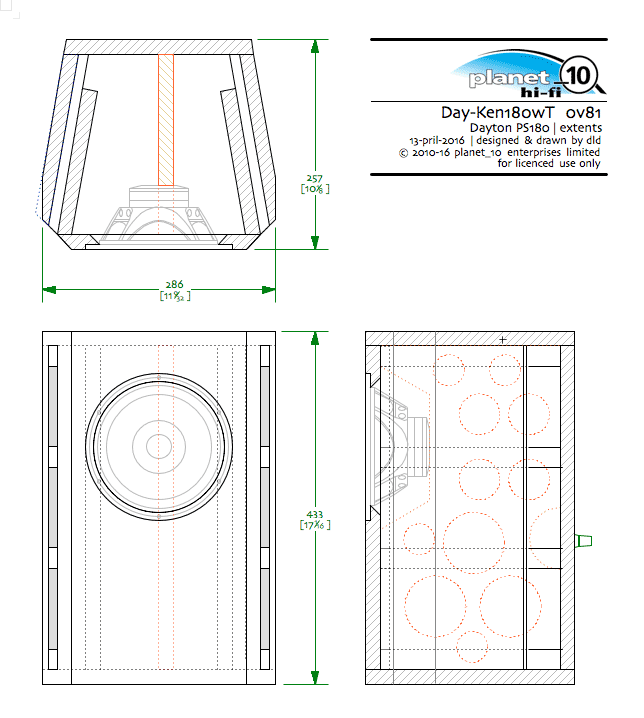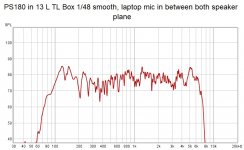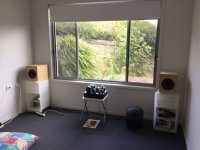So here's a 1-pole highpass "alignment" for the PS220-8 in a 3/4 cubic foot cabinet, with some BSC and decent impedance curve. Maybe make a set of small lightweight speakers with bass for portable use to take to audio club meetings.
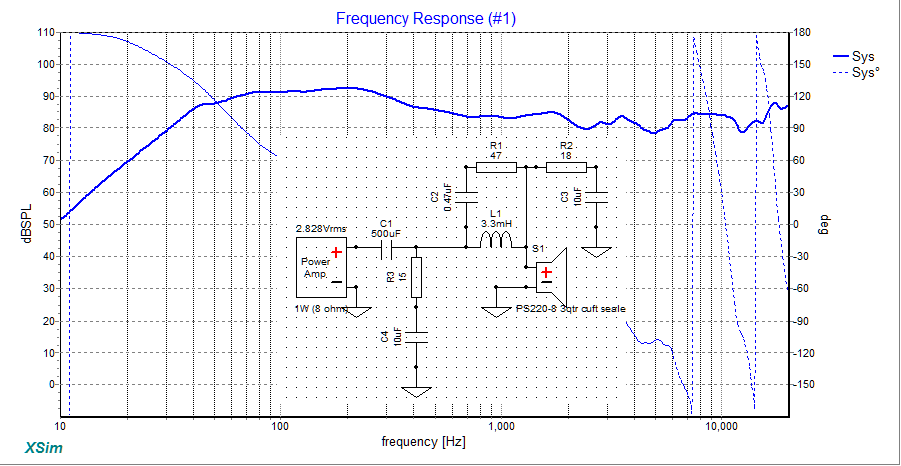
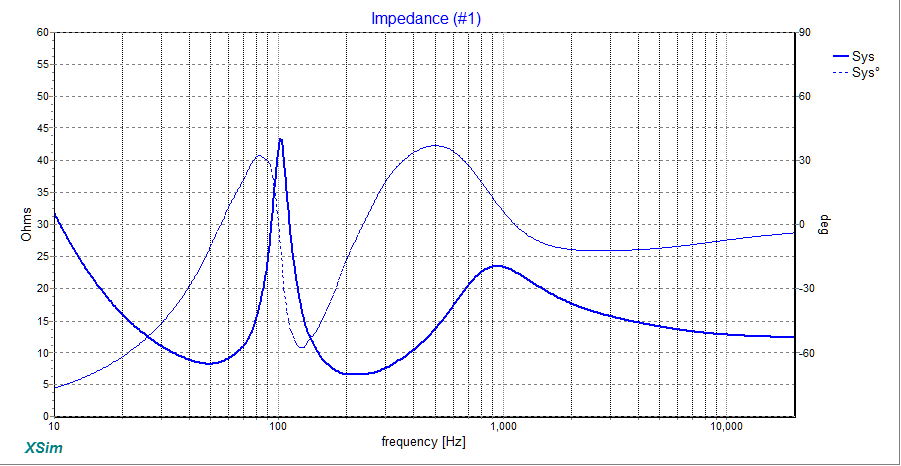
Attachments
Last edited:
Nice work, Bwaslo. I have been intrigued by this driver for a long time. Looks like a lot of shaping is required for this full range driver. With this in place though, response looks great.
gonna be pretty beamy at high frequency though (8" driver doing tweeter work).
The eq network isn't as busy as it looks, btw -- R3 and C4 are only there to bring down the impedance curve in the treble, not really needed.
Here's impedance without those (note the big scale difference)--
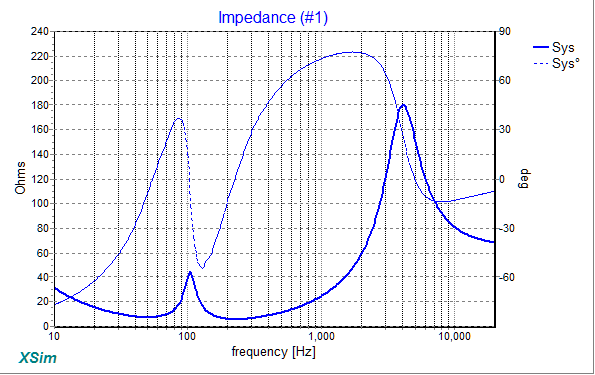
Frequency Response doesn't change.
The eq network isn't as busy as it looks, btw -- R3 and C4 are only there to bring down the impedance curve in the treble, not really needed.
Here's impedance without those (note the big scale difference)--
Frequency Response doesn't change.
Attachments
Last edited:
I don't know anything really about the operation of these circuits but would like to learn. Are there any recommended information sources? Would the circuit be of use in the Labrynth enclosure?I doubt there's much sorting out of that impedance load, at least not if it's going to be used with a SET (probably would work pretty well with a class D ICE amp, though). 🙂
Here's a much less aggressive single-pole version, and in an even smaller box (just a half cubic foot!). I did some baffle step compensation as well. A little fooling around with simulators on a New Years Day morning...
This should be a good SET friendly impedance load, though the literal sensitivity of course suffers from using the BSC. Pretty good for such a small box, though, still gets into the mid 50's.
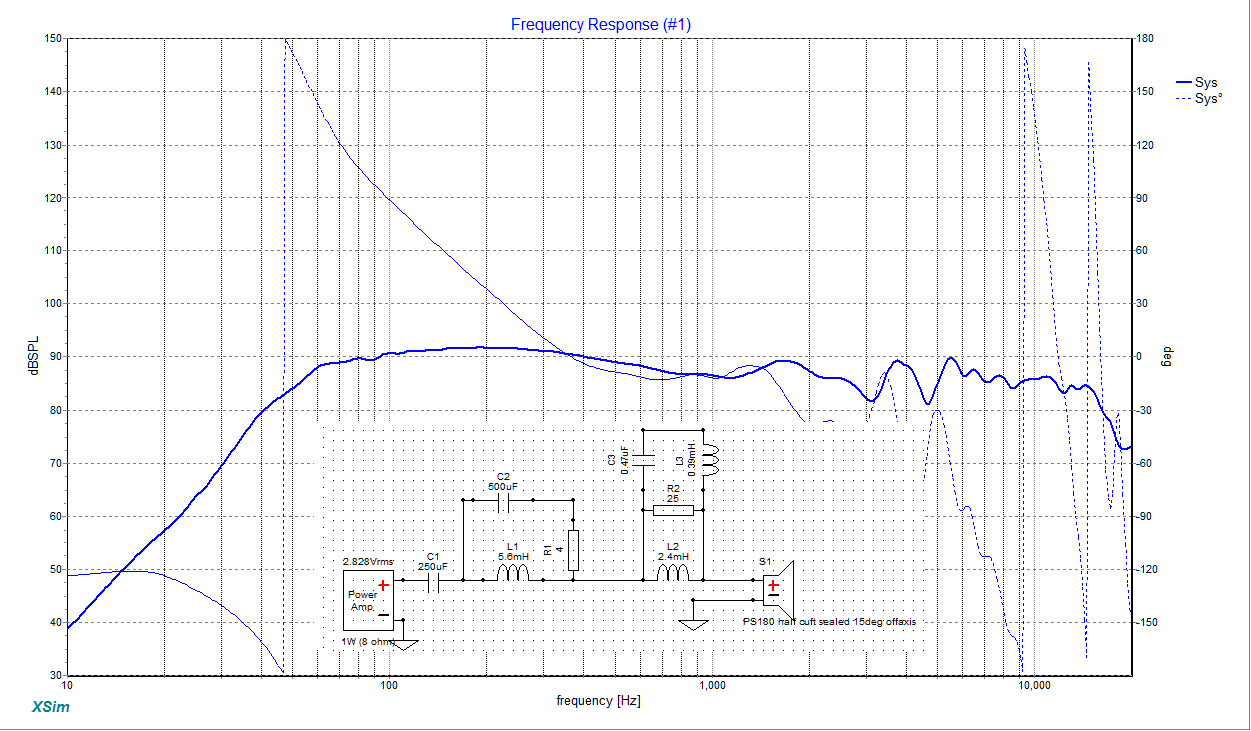
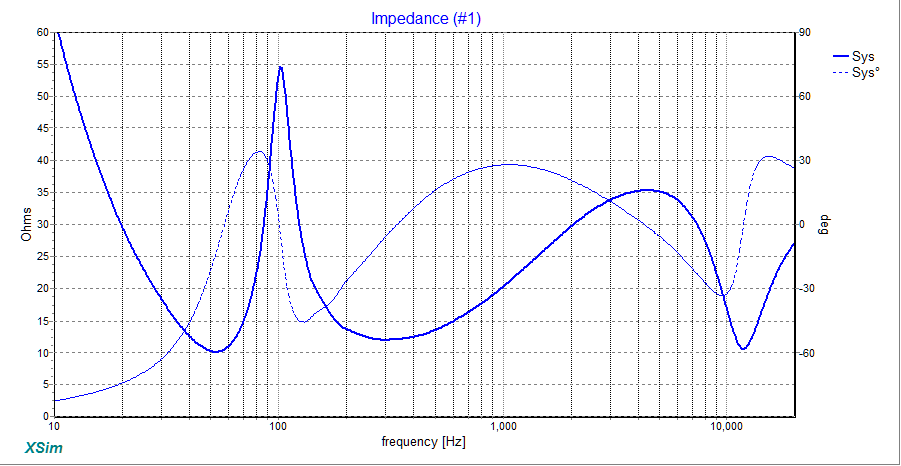
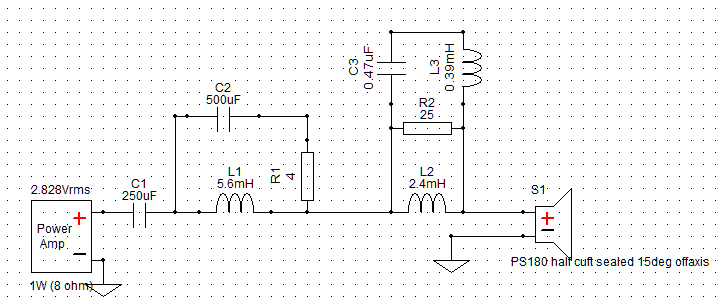
The inductors don't need such low ESR either.
(By the way, this was done from the published T&S parameters and FRD files rather than my own measurements. And the impedance curve was just from the T%S simulation and won't be great for upper frequencies. So no doubt some tweaking for actual unit characteristics and baffle effects, etc., would be advised!)
No academic link I know of, it's just a matching technique sometimes called 'reactance annuling'. Probably the best way to investigate is to install Xsim and download the .dxo file and then play with component values to see what is going on.
Had these speakers going for the last week or so. Probably only about 10 hours play time so far. After listening to the b & w 706s2 speakers behind the diy daytons it is certainly a shock to the ears. 706's sound very smooth, warm and almost relaxing. The more I listen to the daytons they seem to be settling in or maybe my ears are too. Female voices like Amy Winehouse and Christina Aguilera are exposed for their every nuance. Interestingly percussion from the likes of bill bruford and the other king crimson drummers are wonderfully unmuddled and detailed. Bass is somewhat lighter than the 706s which reportedly roll off around 50 Hz. I can still hear tony levin's bass notes coming through quite well enough although I won't expect to hear the lowest notes on my Michael Murray organ Cds. the higher frequencies may be a little challenged in comparison the the 706s but being in my 60s and working in newspapers when young have taken their toll on HF perception anyway. Now they're broken in somewhat I have them connected to the valve amp. Goes well with this setup. Play at a much lower pot setting compared to the 706s. Can easily fill a large room with high SPLs.
Attachments
Last edited:
Hi @bwaslo. Would you mind explaining the objectives of the individual and combination of components in the circuit you posted. From some of the crossover information i kind of understand (maybe to strong a word) the basic functioning of crossover, zobel, and BSC. But how does this circuit work?I doubt there's much sorting out of that impedance load, at least not if it's going to be used with a SET (probably would work pretty well with a class D ICE amp, though). 🙂
Here's a much less aggressive single-pole version, and in an even smaller box (just a half cubic foot!). I did some baffle step compensation as well. A little fooling around with simulators on a New Years Day morning...
This should be a good SET friendly impedance load, though the literal sensitivity of course suffers from using the BSC. Pretty good for such a small box, though, still gets into the mid 50's.



The inductors don't need such low ESR either.
(By the way, this was done from the published T&S parameters and FRD files rather than my own measurements. And the impedance curve was just from the T%S simulation and won't be great for upper frequencies. So no doubt some tweaking for actual unit characteristics and baffle effects, etc., would be advised!)
Hi @bwaslo. Would you mind explaining the objectives of the individual and combination of components in the circuit you posted. From some of the crossover information i kind of understand (maybe to strong a word) the basic functioning of crossover, zobel, and BSC. But how does this circuit work?
Hi woodo,
It's not a 'classical' crossover type. Idealized classical crossover filters give generally pretty poor results in actual use, not a good idea to use unmodified with real-world drivers (which have neither flat response nor flat resistive impedance). Most modern crossover designs (at least the competent ones) are done via software modeling and start with the basic desired filter structures and then modify the components (values or substructure, such as putting R/C or L networks around main components) to achieve the desired response shape and filler rolloffs.
The best way to see what those components do is to download the .dxo design file from https://www.diyaudio.com/forums/attachments/full-range/806007d1577921938-speaker-enclosure-dayton-audio-ps180-driver-ps220-3qtr-cuft-sealed-1storder-dxo
and run it in Xsim. Modify component values to see what they do.
The only unusual aspect of the crossover design is the use of a large series capacitor C1 to resonate with the driver's inductance and bump up the bass response a little.
Thanks. I have installed the model now and having a play. I can see that the C1 cap affects the lower frequencies and other groups affect the mids and highs. I see you have assumed a .5 ft^3 sealed enclosure. does the model allow for different enclosure types eg such as 13 L TL as in my case or is this external to xsim?
Hi Bambinz. Thanks for your sim. I don’t have a decent microphone but if I use my ears I would estimate this is about what I hear. compared to my store bought b and w 2 way speakers, whose specs say an F3 of 50 hz, these roll of somewhat higher. what’s there is nice sounding to me. Voices and percussion mostly i enjoy. some recordings can be in your face a bit compared to the 2 ways.
Hi woodo!
Good 🙂
I see from your simulation that the response is not so flat. Could you measure the response also with a bad microphone? 🙂
Good 🙂
I see from your simulation that the response is not so flat. Could you measure the response also with a bad microphone? 🙂
Hi woodo!
Good 🙂
I see from your simulation that the response is not so flat. Could you measure the response also with a bad microphone? 🙂
I have a pioneer class d amp with a plug in plastic mike that comes with the room equalisation setup and don't think it gives a full frequency Analysis. I assume it's not going to provide the required info but if you can use it it might be worth a try. I prefer the sound anyway with my tube amp of course with no equalisation.
Im struggling with REW but managed to connect my laptop to the amplifier in between the two speaker on about the same plane. I probably need a longer rca cable. No decent microphone just the laptop mic.Hi woodo!
Good 🙂
I see from your simulation that the response is not so flat. Could you measure the response also with a bad microphone? 🙂
Attachments
have been listening almost daily now the last month. if my ears/brain can be relied on i think they’ve turned out rather well and settled down nicely. there’s some music i play such as kraftwerk man-machine where quite a deal of the synth bass is very quiet or missing and luckily I have my other system for that. But Bill Brufords Earthworks and other acid Jazz type music is more suited. i was considering a BSC circuit or @bwaslo suggestion and that is still a possibility. but at the moment I think the balance is good for the room which is quite small and will keep using as is.
Attachments
- Home
- Loudspeakers
- Full Range
- speaker enclosure for dayton audio ps180 driver

